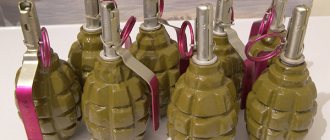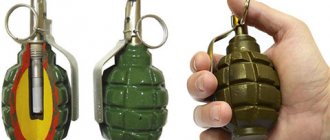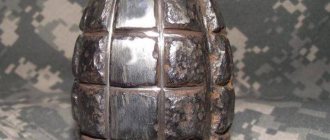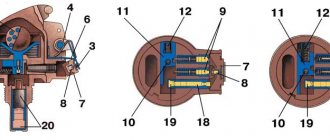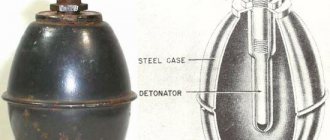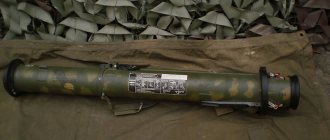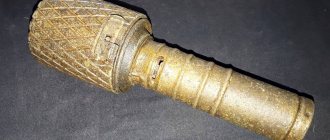Along with the development of evolution, there was a constant improvement of not only tools, but also weapons. The banal stick and stone, thanks to which our ancestors had the opportunity to attack and defend, have now been replaced by a machine gun and an F1 grenade. The characteristics of modern types of weapons are undoubtedly an order of magnitude higher. Take, for example, a grenade. By definition, this is one of the types of explosive ammunition that is intended to disable the opposing side’s equipment or destroy manpower.
History of application
During the Great Patriotic War, hand grenades were widely used. Such explosive ammunition could be divided into fragmentation, illumination, smoke, anti-tank and incendiary. It is worth adding that during the war, tens of thousands of factories and various industries were converted to create such grenades, not counting the fact that a large number of such ammunition were exclusively “handicraft”, which were manufactured in combat conditions by partisans.
Classification
All explosive ammunition, and the F1 grenade is no exception, are divided according to the principle of operation of the detonator and mechanism:
- Electric.
- Mechanical (tension, break, unload and push).
- Chemical.
- Combined.
The electric method of charge detonation is carried out thanks to a current source, while the detonation is carried out directly when the contact is closed. This can be done manually by the bomber himself, or a disguised charge, for example in a TV, is activated when the victim inserts the plug into the socket.
The mechanical method speaks for itself, requiring only human strength or physical impact. At the moment this is the most common method, along with the electric one.
The chemical principle is based on the action of a certain substance or, most often, an acid.
Classification of ammunition according to their purpose
All explosive devices can be divided according to the method of their impact on the target. At the moment, thanks to some modifications and improvements, the F1 combat grenade can be used for any of them. Partisans and modern military operations in the CIS and the Middle East played a significant role in this.
- Planting: This method requires the preliminary installation of an explosive device. When it comes to grenades, the most popular is the tripwire, which is based on a physical detonation by the victim himself. Moreover, it can be either camouflaged or obvious.
- The so-called "mail item", which can be disguised as an ordinary ammunition box and detonates when it is opened.
Varieties of pomegranates
- Manual - performed using a hand throw.
- Anti-personnel - to destroy manpower.
- Fragmentation - damage occurs as a result of fragments from a grenade.
- Defensive - the scattering of fragments exceeds the possible throw range, which makes it necessary to attack from cover.
- Remote action - detonation occurs some time after the throw is performed. The F1 training grenade provides 3.2 and 4.2 seconds. Other explosive devices may have different detonation times.
Subsequent modernization
The F-1 fragmentation grenade had its first baptism of fire during the Soviet-Finnish War of 1939-40. The Red Army soldiers received a very convenient melee weapon. However, during the fighting, two serious shortcomings of the lemon were revealed:
- firstly, Soviet soldiers in most cases had no idea how a fragmentation grenade worked and did not always use it for its intended purpose. This naturally led to frequent accidents when the soldier throwing the grenade himself received mortal wounds and injuries;
- secondly, the remote fuse set the ammunition into action only after 6 seconds. Such a time delay was unacceptable in modern combat conditions.
Having assessed the results of the combat use of hand grenades, it was decided to improve the fuse, ultimately making a more reliable trigger mechanism of a universal type. Engineers Viceni and Bednyakov managed to create a simple and reliable fuse in the shortest possible time, which received the complex abbreviation UZRGM - unified manual grants modernized fuse. Due to its versatility, this fuse has become common since 1942 for all hand grenades in service with the Red Army. Now the time to detonate the main ammunition charge was 3-4 seconds. This type of fuse was subsequently modernized again, receiving the designation UZRGM-2.
UZRGM
Fundamentally, the device did not bring anything new. As in the previous modification, the main parts of the fuse were:
- hammer tube;
- impact mechanism;
- connecting part - bushing;
- guide washer;
- safety lever;
- check.
It was the pipe that was the main element, on the basis of which all other parts of the fuse were already mounted. The main action performed by the assembled mechanism was the ignition of the primer, after which further detonation of the main grenade charge occurred.
Using a connecting sleeve, the fuse was connected to the lemon body. It should be noted that in combat condition the firing pin of the UZRGM is cocked, held in this position by the trigger lever. The movement of the firing pin is ensured by a mainspring, which is held in tension by a safety or trigger lever. As a result of manual manipulation, the grenade, even with the pin pulled out, remains inactive. Only at the moment of throwing, when there is no pressure on the trigger lever, does the firing pin begin to move in the direction of the igniter. This element slows down the ignition reaction of the main detonator capsule. Only after this the main explosive charge of the ammunition is detonated.
Device
F 1 grenades were stored in storage areas in wooden boxes, 20 pcs. in everyone. The fuses for the lemons, like other hand grenades, were stored there. Each wooden box contained two sealed metal containers with UZRGM fuses. The total weight of the grenade box was 20 kg. Even during storage, the fuse is cocked. To put a grenade into combat condition, it is enough to unscrew the plug from the ammunition body and screw in the fuse in its place.
F1 grenade: characteristics, damage radius
Of all the variety of defensive weapons, I would like to highlight the following. The F1 grenade is rightfully considered one of the best anti-personnel, hand-held explosive devices. The characteristics and design turned out to be so good that it managed to exist without any improvements for a large amount of time. The only thing that was modified was the igniter system and its design.
This type of explosive device is designed to hold defensive positions and primarily hit enemy personnel. This is due to the rather large radius of scattering of its fragments. For the same reason, it must be thrown from a shelter (tank, armored vehicle, etc.) in order to avoid causing damage to oneself.
The F1 grenade has the following technical characteristics:
- The number of fragments after the explosion reaches 300 pieces.
- Weight – 600 g.
- The type of explosive is TNT.
- The throw range is on average 37 m.
- Safe distance – 200 m.
- The radius of damage from fragments is 5 m.
Lessons from war
Intelligence agencies from all over the world were interested in the developments and progress of hostilities in Manchuria. Britain sent the most observers to the Far East - it was tormented by the tragic experience of the war with the Boers. The Russian army received three British observers, and 13 British officers observed the fighting from the Japanese side. Together with the British, military attaches from Germany, France, Sweden and other countries watched the development of events. Even Argentina sent captain of the second rank Jose Moneta to Port Arthur.
An analysis of combat operations showed that significant changes must be made to the technical equipment, organization of combat training of troops and their equipment. The war required mass production of all types of weapons and equipment. The role of the rear has increased immeasurably. Uninterrupted supply of troops with ammunition and food began to play a decisive role in achieving success on the battlefield.
With the advent of more advanced weapons, positional forms of fighting in the field arose. Machine guns and repeating rifles forced the final abandonment of dense combat formations of troops; chains became more rare. The machine gun and powerful fortifications sharply increased the possibility of defense, forced the attackers to combine fire and movement, make more careful use of the terrain, dig in, conduct reconnaissance, conduct fire preparations for attacks, widely use detours and envelopments, fight at night, and better organize the interaction of troops on the field. battle. The artillery began to practice firing from closed positions. The war required an increase in the caliber of guns and the widespread use of howitzers.
The Russo-Japanese War made a much stronger impression on German observers than on the French, British and military of other countries. The reason for this was not so much the Germans' greater receptivity to new ideas, but rather the tendency of the German army to view combat operations from a slightly different angle. After the signing of the Anglo-French Agreement (Entente cordiale) in 1904, Kaiser Wilhelm asked Alfred von Schlieffen to develop a plan that would allow Germany to fight a war on two fronts simultaneously, and in December 1905 von Schlieffen began work on his famous plan. The example of the use of grenades and trench mortars during the siege of Port Arthur showed the Germans that such weapons could be effectively used in the German army if it had to face similar tasks during an invasion of the territory of neighboring countries.
Already by 1913, the German military industry began serial production of the Kugelhandgranate 13 grenade. However, it is impossible to say that it was a revolutionary model. The traditional inertia of thinking of military strategists of that time had an effect, which led to the fact that grenades continued to be considered only as means of siege warfare. Model 1913 grenades were of little use as infantry weapons, primarily because of their spherical shape, which made them difficult to carry for a soldier.
Kugelhandgranate 13 Model Aa
The body of the grenade was a reworked, but almost unchanged overall idea from three hundred years ago - a cast iron ball with a diameter of 80 mm with a symmetrically shaped ribbed notch and a fuse point. The grenade charge was a mixed explosive based on black powder, that is, it had a low high-explosive effect, although due to the shape and material of the grenade body it produced rather heavy fragments.
The grenade fuse was quite compact and not bad for its time. It was a tube protruding 40 mm from the grenade body with a grating and spacer compound inside. A safety ring was attached to the tube, and on top there was a wire loop, which activated the fuse. The deceleration time was supposedly about 5-6 seconds. An absolute positive was the absence of any detonator on the grenade, since its powder charge was ignited by the force of the flame from the remote composition of the fuse itself. This increased the safety of handling the grenade and helped reduce the number of accidents. In addition, the charge, which had low brisance, crushed the body into relatively large fragments, producing less “dust” that was harmless to the enemy than grenades in melinite or TNT equipment.
Russia also took into account the experience of the war. In 1909-1910, artillery captain Rdultovsky developed two models of grenades with a remote fuse - a small (two-pound) “for hunting teams” and a large (three-pound) “for fortress warfare.” The small grenade, according to Rdultovsky’s description, had a wooden handle, a body in the form of a rectangular box made of zinc sheet, and was loaded with a quarter pound of melinite. Between the prismatic explosive charge and the walls of the body, plates with cross-shaped cutouts were placed, and ready-made triangular fragments (0.4 g each) were placed in the corners. During tests, fragments “pierced an inch board 1-3 fathoms from the explosion site,” the throwing range reached 40-50 steps.
Grenades were then considered an engineering tool and fell under the jurisdiction of the Main Engineering Directorate (GIU). On September 22, 1911, the Engineering Committee of the State Research University examined hand grenades of several systems - Captain Rdultovsky, Lieutenant Timinsky, Lieutenant Colonel Gruzevich-Nechay. The remark about Timinsky’s grenade was typical: “It can be recommended in case the troops have to make grenades,” that’s how this ammunition was treated then. But the greatest interest was caused by Rdultovsky’s sample, although it required factory production. After modification, Rdultovsky’s grenade was adopted for service under the designation “grenade arr. 1912" (RG-12).
Grenade arr. 1912 (RG-12).
Just before the start of the First World War, Rdultovsky improved the design of his grenade mod. 1912, and the grenade mod. 1914 (RG-14).
Grenade arr. 1914 (RG-14)
The design of the hand grenade mod. 1914 was not fundamentally different from the 1912 model grenade. But there were still changes in the design. The 1912 model grenade did not have an additional detonator. In the 1914 model grenade, when loaded with TNT or melinite, an additional detonator made of pressed tetryl was used, but when loaded with ammonal, an additional detonator was not used. Equipping grenades with different types of explosives led to a variation in their weight characteristics: a grenade loaded with TNT weighed 720 g, melinite - 716-717 g.
The grenade was stored without a fuse and with the striker released. Before throwing, the fighter had to put the grenade on safety and load it. The first meant: remove the ring, pull back the firing pin, recess the lever in the handle (the hook of the lever captured the head of the firing pin), place the safety pin across the trigger window and put the ring back on the handle and lever. The second is to move the funnel lid and insert the fuse with the long arm into the funnel, the short one into the chute and secure the fuse with the lid.
To throw a grenade, the grenade was held in the hand, the ring was moved forward, and the safety pin was moved with the thumb of the free hand. At the same time, the lever compressed the spring and pulled the striker back with its hook. The mainspring was compressed between the clutch and the trigger. When thrown, the lever was pressed back, the mainspring pushed the firing pin, and it pierced the igniter primer with the striker. The fire was transmitted along the threads of the stopin to the retarding composition, and then to the detonator cap, which detonated the explosive charge. Here, perhaps, are all the contemporary examples of hand grenades that were in the arsenals of the military when the Great War broke out.
History of F1
It all started back in 1922, when the department of the Workers' and Peasants' Red Army decided to conduct an audit of artillery warehouses. According to reports of the time, they were armed with 17 different types of grenades. Moreover, among the numerous selection of types of fragmentation-defensive nature, there were no explosive devices of our own production at that time. It was because of this that grenades from the Mills system were in service; as an exception, the use of the French version of the F-1 explosive device was allowed. And based on the fact that the French fuse was extremely unreliable, a large number were not put into action, and even moreover, they exploded right in the hands. The same committee, as of 1925, created a report that stated that the army's need for such explosive devices was only 0.5% satisfied. In the same year, Artcom decided to carry out tests of all samples that were available at that time. Based on this, a 1914 model grenade was selected, which was to be modified to an improved analogue of the Mills fragmentation system.
Thus, the Swiss fuses were replaced with domestic ones - Koveshnikov, and already in 1925, in September, the first tests were carried out, in which the main criterion was fragmentation damage. The commission's findings satisfied the committee. This is how the F1 grenade appeared, the technical characteristics of which were superior to its French counterpart and met the needs of the Red Army.
Advantages and disadvantages
The F-1 grenade has been in service with many armies for decades. In the near future, and even in the distant future, it is unlikely to be discontinued.
The reason for this is its undeniable advantages.
- Ease of manufacture and low cost of the material from which the body is made.
- A simple and reliable fuse that operates remotely and reliably.
- High lethality, especially in confined spaces.
The disadvantages of this projectile include the very small fragments formed during the explosion. They have low lethality.
The disadvantage of its fuse is that the moderator gives the enemy a chance of salvation, albeit a small one. The F-1 is a rather heavy projectile; not everyone can throw more than half a kilogram of cargo far and accurately.
Offensive grenades RGD are a kind of analogue of the F-1. But they are twice as light as it, but they also contain twice as much explosive. The RGD grenade has the same type of fuse as the F-1.
Due to the smaller number of fragments, but a greater high-explosive effect, it is used in offensive operations.
Another type is the Rgn offensive grenade. Their advantage over F1 is also their lighter weight.
In addition, the range of action of both the RGD and RGN is of considerable importance - 15 - 20 meters.
Instructions for use
In order for the F1 grenade to be ready for action, it is necessary to find the antennae that are located on the safety pin and straighten them. The explosive device is taken in the right hand, the fingers should firmly and confidently press the lever directly to the body itself. Before throwing, you need to pull out the pin ring with the index finger of your second hand. After this, you can hold the grenade for a long time, until the lever is released and the striker activates the fuse. If the grenade is no longer needed, the pin can be inserted back, and after the antennae have been returned to their original position, it can be safely stored.
Having examined the dummy F1 grenade, you can fully familiarize yourself with its structure, and thanks to its weight, which is identical to the combat version, you can test its throwing range. In the case of combat operations or conditions close to them, you must first decide on the target and choose the right moment to perform the throw. Once the grenade is on its way to its target, the lever will apply pressure to the firing pin, which in turn will press on the primer, causing an explosion after a certain period of time.
Among the damaging factors, one can note not only the high-explosive effect, but also the fragments that are formed as a result of the rupture of the grenade shell. This is also due to the frequent use of F1 when installing “stretch marks”. So, if during an explosion a person can survive a high-explosive shock wave, then the fragments will leave no chance for anyone within a radius of 5 meters.
Additionally, it is worth noting a rather cunning and effective combination that consists of 2 grenades, thanks to which an anti-sapper effect is created. So, if it is discovered by an inexperienced sapper, who subsequently cuts the tensioned cable, 2 fuses are detonated simultaneously. There are modifications that allow grenades with the installation of an instant-activation mine fuse to operate instantly.
Real use in combat
In open areas, the high-explosive effect (overpressure damage) of F-1 is noticeable at a distance of 3 - 5 meters from the explosion site. The radius of action of fragments (confident destruction) reaches 50, sometimes 70 meters.
The largest fragments can fly 200 meters from the epicenter of the explosion.
These features also dictate the methods of using a grenade in battle:
- it is most effective in confined spaces, that is, in rooms where the destructive power of fragments is maximum;
- indoors and the high-explosive effect is enhanced several times, which leads to concussions and also completely disorients;
- F-1 is very useful when organizing sabotage as the main element of tripwires, as well as for blowing up vehicles, warehouses, etc.
Sometimes tripwires are placed using two or more grenades.
And if you remove the moderator, you can achieve one important advantage, i.e., an instant explosion.
The same effect will be given by grenades equipped with a mine fuse, which acts instantly.
For security
In order to avoid any unfortunate situations, it is necessary to be very careful about precautions. Before laying grenades, you need to inspect them and pay attention to the fuse. There should be no deep rust or severe dents on the body. The igniter and its tube should have no traces of corrosion, the pin should be intact, the ends should be apart, and the bends should be without cracks. If a green coating is found on the fuse, then under no circumstances should you use such a grenade. When transporting ammunition, it is necessary to protect it from shock, dampness, fire and dirt. If the pomegranates have been soaked, you should not dry them near the fire.
Systematic inspections must be carried out. It is strictly prohibited:
- Touch an unexploded shell.
- Disassemble a live grenade.
- Try to remove the problem yourself.
- Carry grenades without bags.
Analogs
The French fragmentation and English models were taken as a basis, thanks to which the F1 grenade appeared. The characteristics of such a symbiosis were unique in comparison with similar domestic explosive devices. This model is known by its nickname "lemon". In turn, models from Chile (Mk2), China (Type 1), Taiwan and Poland (F-1) can be considered copies of this grenade.
The Soviet version was widely used throughout the world in the most famous and extensive military conflicts.
First World War
On July 28, 1914, World War I began, one of the largest armed conflicts in human history, as a result of which four empires ceased to exist. When, after an extremely dynamic campaign, the front lines froze in trench warfare and the opponents sat in their deep trenches almost a stone's throw away, the history of the Russo-Japanese War repeated itself again, but with one exception - Germany. The Kugelhandgranate spherical grenade turned out to be the very first to be mass-produced in fairly large quantities and supplied to the troops. The rest had to improvise again. The troops began to help themselves and began to produce various homemade grenades. Using empty cans, wooden boxes, cardboard, pipe scraps and the like, often wrapped with wire or nailed, more or less effective explosive devices were produced. Also, the charges and detonators were very diverse - simple fuse cords, grating fuses, and so on. The use of such ersatz was often associated with risk for the throwers themselves. It required a certain dexterity and composure, and was therefore limited to sapper units and small, specially trained infantry units.
In relation to the effort spent on production, the effectiveness of homemade grenades left much to be desired. Therefore, at an increasing pace, more effective and convenient grenades began to be developed, suitable, in addition, for serial mass production.
It is not possible to consider all the samples that designers created during the First World War in the volume of one article. Only in the German army during this period 23 types of different hand grenades were used. Therefore, we will focus on two designs that ultimately led to the appearance of the F-1 grenade.
Taking into account the experience of combat in 1914, the British designer William Mills developed a very successful, one might say, classic model of a grenade. The Mills grenade was adopted by the British Army in 1915 under the name "Mills Bomb No. 5".
Mills Bomb No. 5
The Mills grenade belongs to the anti-personnel fragmentation hand grenades of the defensive type.
Grenade No. 5 consists of a body, an explosive charge, a shock-safety mechanism, and a fuse. The grenade body is designed to accommodate an explosive charge and form fragments during an explosion. The body is made of cast iron and has transverse and longitudinal notches on the outside. There is a hole at the bottom of the body into which the central tube is screwed. The central channel of the tube houses a firing pin with a mainspring and a primer-igniter. The fuse itself is a piece of fire cord, at one end of which an igniter cap is attached, and at the other a detonator cap. It is inserted into the side channel of the tube. The housing hole is closed with a screw plug. To use the Mills Bomb No. 5 grenade, you need to unscrew the washer on the underside of the grenade, insert the detonator cap into it and screw the washer back into place. To use a grenade, you need to take the grenade in your right hand, pressing the lever against the body of the grenade; With your left hand, bring together the antennae of the safety pin (cotter pin) and, pulling the ring, pull the cotter pin out of the lever hole. After that, swing, throw a grenade at the target and take cover.
The British managed to create a truly outstanding weapon. The Mills grenade embodied the tactical requirements of “trench warfare” for this type of weapon. Small, convenient, this grenade was conveniently thrown from any position; despite its size, it produced quite a lot of heavy fragments, creating a sufficient destruction area. But the greatest advantage of the grenade was its fuse. This was due to the simplicity of its design, compactness (there were no protruding parts), and the fact that, having pulled out the ring with the pin, the fighter could safely hold the grenade in his hand, waiting for the most favorable moment to throw, since the lever held by the hand would not rise , the moderator will not ignite. German, Austro-Hungarian and some French examples of grenades did not have this truly necessary feature. The Russian Rdultovsky grenade, which had this feature, was very difficult to use; its preparation for throwing required more than a dozen operations.
The French, who suffered no less than the British from German grenades in 1914, also decided to create a grenade with balanced characteristics. Correctly taking into account the shortcomings of German grenades, such as a large diameter, awkward body to grasp with the hand, like a grenade of the 1913 model, an unreliable fuse and weak fragmentation effect, the French developed a grenade design that was revolutionary for its time, known as the F1.
F1 with impact ignition fuse
The F1 was originally produced with a impact ignition fuse, but was soon equipped with an automatic lever ignition, the design of which, with minor modifications, is still used in many NATO armies' fuses today. The grenade was a molded, ribbed, egg-shaped body made of steel cast iron, with a hole for the fuse, which was easier to throw than the round or disc-shaped body of German grenades. The charge consisted of 64 grams of explosive (TNT, Schneiderite or less powerful substitutes), and the mass of the grenade was 690 grams.
Initially, the fuse was a design with a percussion igniter primer and a moderator, upon the burnout of which the detonator cap was activated, causing the grenade to explode. It was activated by hitting the fuse cap on a hard object (wood, stone, butt, etc.). The cap was made of steel or brass and had a firing pin on the inside that broke the capsule, like a rifle, and ignited the retarder. For safety, the F1 grenade fuses were equipped with a wire pin that prevented the firing pin from touching the primer. Before throwing this fuse was removed. Such a simple design was good for mass production, but using the grenade outside the trench, when it was not possible to find that very solid object, clearly made it difficult to use the grenade. Nevertheless, compactness, simplicity and high efficiency ensured the grenade's enormous popularity.
At the moment of explosion, the grenade body breaks into more than 200 large heavy fragments, the initial speed of which is about 730 m/s. In this case, 38% of the mass of the body is used to form lethal fragments, the rest is simply sprayed. The reduced area of scattering of fragments is 75–82 m2.
The F1 hand grenade was quite technologically advanced, did not require scarce raw materials, carried a moderate explosive charge and at the same time had great power and produced a large number of lethal fragments for those times. Trying to solve the problem of correct crushing of the hull during an explosion, the designers used a deep notch on the hull. However, combat experience has shown that with modern high explosives, a body of this shape fragments unpredictably during an explosion, and the majority of fragments have a low mass and are low-killing within a radius of 20-25 meters, while heavy fragments of the bottom, the top of the grenade and the fuse have a high energy due to its mass and are dangerous up to 200 m. Therefore, all statements that the notch is intended to form fragments in the shape of protruding ribs are, at a minimum, incorrect. The same should be said about the clearly overestimated destruction distance, since the range of continuous destruction by fragments does not exceed 10-15 meters, and the effective range, that is, the one where at least half of the targets will be hit, is 25-30 meters. The figure of 200 meters is not the range of destruction, but the range of safe removal for friendly units. Therefore, the grenade had to be thrown from behind cover, which was quite convenient in case of trench warfare.
The disadvantages of the F1 with its percussion fuse were quickly taken into account. The imperfect fuse was the Achilles heel of the entire design, and in comparison with the Mills grenade it was clearly outdated. The design of the grenade itself, its effectiveness and production features did not cause any complaints; on the contrary, they were outstanding.
At the same time, in 1915, in a short period of time, French designers invented an automatic spring igniter of the Mills type, however, in many ways superior to it.
F1 with an automatic lever fuse
Now a grenade ready to be thrown could be held in the hands indefinitely - until a more favorable moment for throwing came, which was especially valuable in a short-lived battle.
The new automatic igniter was combined with a moderator and detonator. The fuse was screwed into the grenade from above, while in Mills the firing mechanism of the fuse was integral to the body, and the detonator was inserted from below, which was very impractical - it was impossible to visually determine whether the grenade was loaded. The new F1 did not have this problem - the presence of a fuse was easily determined and meant the grenade was ready for use. The remaining parameters, including the charge and burning rate of the moderator, remained the same, as with the F1 grenade with an impact ignition fuse. In this form, the French F1 hand grenade, like the Mills grenade, became a truly revolutionary technical solution. Its shape and weight and dimensions were so successful that they served as an example to follow and were embodied in many modern grenade models.
During the First World War, F 1 grenades were supplied in large quantities to the Russian army. As in the West, the fighting soon revealed the urgent need to arm the Russian army with hand grenades. This was done at the Main Military Technical Directorate (GVTU), the successor to the State Military Institution. Despite the new proposals, the main ones are grenades arr. 1912 and 1914. Their production is being established in state-owned technical artillery establishments - but, alas, too slowly. From the beginning of the war to January 1, 1915, only 395,930 grenades were sent to the troops, mostly mod. 1912 Since the spring of 1915, grenades gradually come under the jurisdiction of the Main Artillery Directorate (GAU) and are included among the “main means of artillery supply.”
By May 1, 1915, 454,800 model grenades were sent to the troops. 1912 and 155 720 - arr. 1914 Meanwhile, in July of the same year, the Head of the GAU estimates only the monthly need for hand grenades at 1,800,000 pieces, and the Chief of Staff of the Supreme Commander-in-Chief informs the Administrator of the War Ministry of the Supreme’s opinion on the need to procure “revolvers, daggers and, especially, grenades” with reference to experience of the French army. Portable weapons and hand grenades really become the main weapons of the infantry in trench warfare (at the same time, by the way, means of protection against hand grenades appeared in the form of nets over the trenches).
In August 1915, a demand was made to increase the supply of grenades to 3.5 million pieces per month. The range of use of grenades is growing - August 25 The Commander-in-Chief of the armies of the North-Western Front asks for the supply of “hand bombs” to the partisan hundreds for operations behind enemy lines. By this time, the Okhtensky and Samara explosives factories had delivered 577,290 model grenades. 1912 and 780,336 grenades mod. 1914, i.e. their production for the whole year of the war amounted to only 2,307,626 units. To solve the problem, orders for grenades are being placed abroad. Among other samples, F1 is also supplied to Russia. And together with others, after the end of the World War and the Civil War, it is inherited by the Red Army.
The uniqueness of the F1 grenade
In fact, the fact that this type of ammunition did not need modification for quite a long time speaks volumes, in particular, that the F1 grenade is considered one of the best developments of that time. The characteristics of this device are so good, and production is simple, that by the beginning of 1980 there was a huge stock of similar supplies in warehouses, all of which were in working order. At the moment, they remain, if not the most perfect type, then time-tested.
Perhaps, after some time, new, completely unique types will be created that will be completely devoid of all the shortcomings of old ammunition and will confidently take their place, but at the moment the F1 grenade remains one of the best. The characteristics (the expert’s comment confirms this) of new types of explosive devices have some advantage, but it is not yet possible to call them the best replacement for old types of grenades.
Lemon and features of its use
There are some features of storing this projectile. They consist in the fact that the fuse and the body with the explosive are stored separately in a wooden box. The fuse is screwed into the grenade before the battle.
In the operating instructions, the article on storing fuses states that they should be kept in special sealed boxes. This is to prevent them from corroding.
How to distinguish a training grenade from a combat one? In this sense, labeling is of particular importance. Combat grenades are painted green and dark green. And the grenade model is painted black.
This is done in order to visually immediately distinguish a combat grenade from an imitation grenade. And the latter, naturally, is used to avoid accidents during soldier training.
But this is not the only way to distinguish them. The model of the training grenade has 1 ring from the pin, as well as the lower part, the very tip of the lever, which must be pressed after removing the pin, is painted red.
Soldiers must carry grenades in a special pouch designed for two projectiles. Or in unloading, and transportation in pockets is also allowed. But under no circumstances should you hook the projectiles to the belt by the pin rings.
